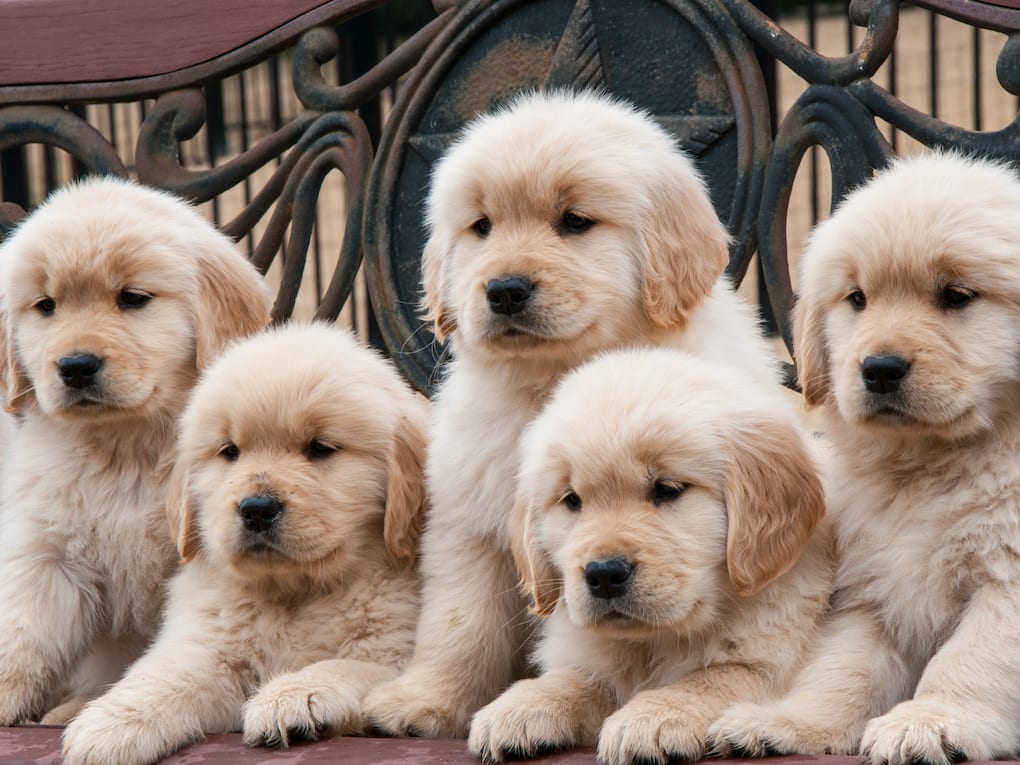Known for their sunny coat and disposition, Golden Retrievers are widely recognized as one of the most popular dog breeds in America. Unfortunately, Golden Retrievers are also overrepresented for certain diseases, with more documented mortalities due to cancer than nearly any other breed (Kent et al. 2018; Dobson 2013).
The Golden Retriever Lifetime Study by the Morris Animal Foundation is a large, comprehensive study of canine health in the United States. It follows a cohort of over 3,000 Golden Retrievers throughout their lives, aiming to understand genetic and environmental factors that affect health and lifespan in the breed.
Through our research partnership with the Morris Animal Foundation, Embark studied a cohort of female intact Golden Retrievers who participated in the study.
Our Science team, led by Adam Boyko, PhD, found that inbreeding depression resulted in reduced litter sizes in purebred Golden Retrievers. This study was published in the scientific journal Mammalian Genome in 2019.
What is “inbreeding depression”?
“Inbreeding is the mating of individuals or organisms that are genetically closely related, resulting in increased homozygosity and consequently an increase in the occurrence of recessive traits,” according to Nature.
The term “inbreeding depression” refers to the reduction of a trait due to a sustained rate of breeding of closely related individuals. Inbreeding depression has been extensively studied in plants and many wild or endangered animal species. Scientists are also now using inbreeding depression to study domestic animals, including horses and dogs.
Because most purebred dogs are descended from a handful of founding ancestors, dogs—like the Golden Retrievers in this study—offer a significant opportunity to study inbreeding depression.
Using genetics to measure inbreeding depression
In the past, estimates of inbreeding have relied on information from in-depth pedigrees, resulting in a coefficient of inbreeding (COI).In 2019, this study by Embark scientists was one of the first to use genetic measures of inbreeding in domestic dogs to produce a genetic COI, rather than using pedigree-based estimates.
Why use genetic COI instead of pedigree-based COI? Genetic measures of COI are based on runs of homozygosity (labeled as FROH in the publication).
Runs of homozygosity refer to long, contiguous stretches of homozygous genotypes. They arise when an individual inherits the same genetic information from both parents.
These runs of homozygosity offer an accurate way to quantify COI. Individuals who have experienced recent inbreeding will often have long runs of homozygosity in their DNA.
Genetic COI has proven more effective than pedigrees (Huisman et al. 2016) in assessing inbreeding and fitness in animal and human populations (Brüniche-Olsen et al. 2018). Some wildlife conservation programs already use these genetic techniques to measure COI and preserve genetic diversity.
Learn more about genetic COI and how to quantify inbreeding in this in-depth explanation with Dr. Boyko.
Indicators of inbreeding depression
As accurate as genetic techniques are for measuring COI, phenotypic data are also necessary to detect inbreeding depression. Physical indicators of inbreeding depression could include birth rates, mortality rates, litter size, reproductive success, body size, and performance traits.
Effects of inbreeding depression in Golden Retrievers
In this study, Embark scientists found a statistically significant decrease in litter sizes with higher levels of COI. Every 10% increase in genetic COI led to a litter size decreasing by one puppy. For details, see the figure below.
Strikingly, the only variable that significantly impacted litter size in the cohort they studied was FROH. Other factors they examined included body size and age at time of parturition.
Figure 1: Higher Genetic COI Associated with Smaller Litter Size

Higher FROH is associated with lower litter size. Dams are binned into lower (blue), middle (yellow), and upper thirds (red) by FROH. Each point represents the average number of puppies born in a single litter. Median litter size is similar between middle and upper third FROH bins, but the uppermost or most inbred third also has appreciably more litters with below-average litter size.
This figure is reproduced under the Creative Commons Attribution 4.0 International License. Source: Chu, E.T., Simpson, M.J., Diehl, K. et al. Inbreeding depression causes reduced fecundity in Golden Retrievers. Mamm Genome 30, 166–172 (2019). https://doi.org/10.1007/s00335-019-09805-
Genetic COI can inform a healthy future for purebred dogs
“We believe that this work sets the stage for a much larger population analysis,” says Dr. Adam Boyko, Chief Science Officer at Embark and one of the principal investigators of the study.
Future research could investigate genomic regions associated with fecundity and other measures of fitness, including early fetal resorption, incidence of dystocia or perinatal complications, or, from the male point of view, sperm count or motility. Future studies might also examine the implications of FROH for the predicted COI of the litter.
High-resolution genotyping could be invaluable to maintaining a healthy future for beloved dog breeds. Regions of the genome associated with aspects of inbreeding depression could be pinpointed and breeding recommendations could be made to increase heterozygosity in these regions.
Learn more about how genetic COI can inform breeding decisions in this video with Dr. Aaron Sams, Director of Research and Scientific Product Development at Embark.














